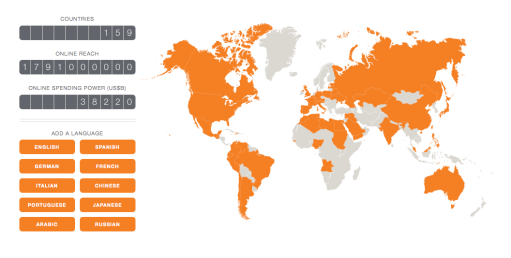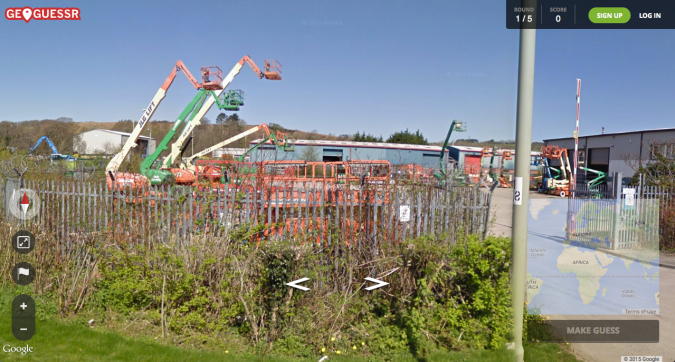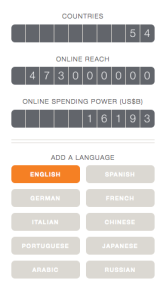Smartling: Communication in the 21st Century Classroom
In my experiences preparing to educate 21st century learners, I am fascinated by the GLOBAL footprint our students are able to have. The ability to reach beyond the four walls of the classroom, and beyond the school itself, is more real than ever. Because of this, I was thrilled when I found Smartling, a company that translates websites, and it got me thinking about the value of foreign language education in the digital world and its connection with classroom teachers.
In connecting a website translation company to what we, as educators, tackle on a daily basis, it is my hope to view the idea through a distinct lens regarding the value of foreign language education and the creative ways in which students can have their digital and global horizons broadened! Before looking more closely at these key questions, here’s a closer look at exactly what Smartling does.
The Smartling Story from Smartling on Vimeo.
My first reaction was YES! The wheels are already turning with regard to the positive impact this can have on global classroom connections. So let’s jump right in!!
What is the value of foreign language education or being multilingual? What is out there to help broaden students’ perspective and global citizenship?
This value speaks for itself (no pun intended). If we are truly striving to prepare our students to be competent 21st century citizens, communication is imperative. Being multilingual not only helps our students be more marketable, but gives them opportunities to see the world and make connections that weren’t possible before. I’ll go one step further, one of these languages should be a computer language. Teaching our students to code is just as critical, and in my opinion, can be an even more beneficial ‘foreign language.’ Using Smartling’s interactive graphic, let’s analyze what happens to a students’ global citizenship when we teach them just one more language.
31 additional countries can be communicated with, almost 700 million more reached online, and almost $3000 in online spending power. When I look at these graphics, though, I can’t help but wonder how the reach of our classrooms would expand with accessibility to all 10 of the languages offered by Smartling! Of course, it is impossible to teach our students 10 languages, but this is the value of a service such as Smartling… by using web platforms to connect classrooms, translated and made accessible through Smartling, our students’ digital presence could look like this!

Using multilingual websites and applications to communicate with classrooms around the world can be one of the most rewarding and enriching learning experiences for students. Personally, I am platforms to programs like MysterySkype or GeoGuessr. MysterySkype partners classrooms around the world with each other in a sort of “Guess Who” game in which students ask each other questions, attempting to guess where in the world their fellow students are.
GeoGuessr, tailored more toward more advanced students, virtually drops students down with a GoogleMaps Street View camera to a place somewhere in the world. They are able to navigate and zoom, look at license plates, read street signs, observe housing, transportation, and landscape, and investigate to their heart’s desire. Then, using no more than 5 guesses, they must try to see how close (in miles) they can get to the actual location.

These are all wonderful ways for students to raise their global awareness and enhance their global network/citizenship without leaving their desk or even setting down that 1:1 device.
Knowing these applications are out there, and the importance of the experience they provide, the underlying question that remains for me is this: As a student preparing to teach in the 21st Century Classroom, what can I do to be ready to tackle this challenge, and how can my students be multilingual, global citizens?
I don’t think there is a single-faceted answer to this question, yet through my classroom experiences and research/work with Smartling’s services, I can see some definite stepping stones to progress in this direction. As more teachers my age enter the classroom, we need to be aware of a few things:
1) All of our students will NOT speak English at home.
2) We have, at our disposal, the resources to take our students anywhere in the world.
3) We can make learning real and lasting for our students
By embracing these key ideals, it is increasingly clear the imperative nature of creating a classroom environment that fosters multilingual experiences. By acknowledging the fact that students will all bring various languages to their learning, I feel the best thing to do is realize it’s not about me. Students are the center. Let them take the lead. By allowing students of different linguistic backgrounds to take the class on a virtual field trip or peer teach a lesson on some words or phrases in their language, not only are we embracing inner-class diversity, but students are encouraged to take pride in their heritage and value their differences. Taking this outside the four walls of the classroom was once impossible, with technology it became more accessible, and thanks to Smartling, spanning the language gap/barrier when connecting with other classrooms can be even simpler.
At the end of the day, my ‘battle cry’ is no different…we are still teaching human beings. Our job, as teachers, is to pump out 25 better kids at the end of the day…regardless of what content they mastered or standard they met. Part of developing these human beings is fostering global learning and raising their awareness and appreciation for the world around them. Breaking down communicative barriers, language gaps, and moving virtually beyond our classroom, our language, and our nation, fosters not only intellectual development, but social, emotional, and linguistic development…and that is what it takes to teach human beings…to change how our children see the world.
A Semester in Social Studies Methods
My writing prompt for today was as follows: “Reflect on your “renewed learning” in social studies this semester.”
I stared at this for a moment and realized that, for me, renewed learning didn’t happen. Honestly, I experienced more “reinvigorated frustration” than I did “renewed learning”…and here’s why. Not only do we marginalize social studies (and science) instruction at the elementary level, we are failing to practice what we preach in higher education. Social Studies Methods courses meet for half as many hours and are worth half as many credits as Math and Language Arts…science is in the same boat. Projects are easier, workload is less, and quite frankly, for over half of the semester, Social Studies Methods courses often simply talk about classroom management…shading it with the justification of “We’re studying how students interact; that’s “social” studies.” In an effort to not undermine my institution (which I love SO dearly) or slap administration, professors, and faculty across the face in higher ed in general, I will not say this is happening everywhere. Yet, more places than not, we are simply failing to effectively prepare future teachers to competently teach social studies and science. This translates to less confidence in the classroom, a lesser likelihood of that content being covered, and another classroom of students, in the end, which marginalizes content areas. It’s a vicious circle.
“It’s easy to sit back and make these claims, Andrew, but how do we fix it?!” …I can hear you through my keyboard… I’m not sure there is a right or wrong answer right now because we are SO deep in this cycle. Just how deep? Ask Google… just today, searching “social studies and science” turns up two suggestions below. Can you guess them?
But what I can say is, AS EDUCATORS, the best course of action is to take ownership! Don’t get me wrong, I get it…marginalization is perpetuated by the common core, it’s perpetuated by common assessment, it’s perpetuated by standards…yet, I urge you to integrate! Get creative, go cross-curricular, make the time to do your students a favor and dive in to these important content areas. Students will be excited and invigorated as they experience variety in instruction and new content. Share ideas, collaborate, team-teach, connect with other content…do whatever it takes.
Okay, off my soap-box and time to answer the question so I actually get credit for this… “What has my renewed learning been this semester?” I have been renewed in my passion and drive to ensure effective social studies instruction at all levels…this starts in the primary grades and stretches to higher education. I have been renewed in my desire to impact this field. I have been renewed in my longing for great, hands-on, immersive, and experiential social studies and science learning. Above all, though, I have been renewed in my belief that I can make a difference in a child through effective, varied, and exciting instruction…and that great educators all over can do the same.




